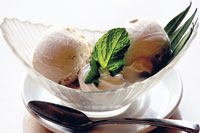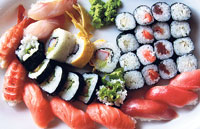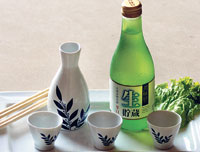I have a friend who insists that the first mouthful of sashimi - touched with wasabi, soaked in soy sauce - is the taste of happiness. Considering that this is raw fish we’re talking about, not everyone will go that far. Still, in the past few years, Japanese cuisine has gained a faithful following in Sri Lanka. So much so that Colombo itself boasts nearly eight Japanese restaurants – almost all of which meet international standards on the quality of their cuisine. You can even eat premium sashimi in Sri Lanka at more affordable rates than you could in India or Singapore.
 |
| Chef Clifford Perera |
As local gastronomes get more adventurous, hotels have added to their menus. Now you can savour Norwegian salmon sashimi, sip imported sencha tea from Japan and linger over red bean ice cream for dessert – all with the righteous satisfaction of someone who is eating healthy food.
If you are so inclined, you could even attempt a temaki roll at home – the ingredients, including tubes full of potent wasabi are available in local stores like Brahnas at the Kollupitiya market.
To the novice, Japanese food might consist primarily of unhygienic, smelly fish but this couldn’t be further from reality. Not only does the average menu contain a wide range of cooked foods, the fish should never ever be smelly. Two things are of utmost importance, says Executive Sous Chef Clifford Perera of Cinnamon Lakeside – the freshness of the produce and the cut of the meat. He says, the fish practically leaps out of the ocean and into his sushi bar display. It’s brought in fresh, cleaned painstakingly and immediately frozen, says Chef Perera explaining the special methods of packing and storage are employed. Only fillets are used and the cuts are chosen to remove any trace of skin or bone. All you are left with is an almost buttery slice of fish.
At Chef Perera’s sushi bar, things are getting interesting. He and his team have just introduced two new platters, available throughout this month. The Sushi Moriawase Platter (Rs. 1,500 nett) includes an assortment of Chef’s choice of nigiri and maki for two people.
The Cinnamon Lakeside Platter (Rs. 2,000 nett) offers nigiri sushi, Californian maki and sashimi. A miso soup for two is also thrown in. You’ll find that your soup doesn’t come to your table first instead it appears as you eat. Miso (Rs. 230) is a Japanese favourite. Along with rice it’s drunk for breakfast, a practice that I for one am considering adopting. As is traditional, the soup is made from soya bean paste, and is served with a rotating cast of ingredients, including tofu and fresh bean sprouts. Served in lacquer bowls, miso is meant to be sipped while you eat. Use your chopsticks to fish out the solid ingredients.
Now, if you’re still feeling queasy, there’s nothing like actually heading over and sitting down in front of your own platter to help you summon your courage. It has been said that the Japanese eat with their eyes, and if you don’t linger on the anatomic improbability of that description, you can see why.
Sashimi is traditionally served on heaps of grated radish and is beautifully presented. In his sashimi moriawase (Rs. 890), Chef Perera uses four types of fish, including raw cuttlefish, to create an appealing colour palate. The radish is meant to be eaten by the mouthful and helps cleanse your palate between bites. (Some dishes are served with thin slices of ginger for the same reason.)
The little spot of green paste on the side is wasabi. Capable of making your eyes tear and your sinuses burn, this paste is made from the root known as Japanese horseradish. It is meant to be lightly smeared on a sashimi before you dip it into your small bowl of soy sauce.
If you’re eating with chopsticks, it’s the sticky rice that often presents the biggest challenge. When served in sushi, the rice is combined with seasoned rice vinegar to create vinegar rice.
It is then topped with other ingredients, such as fish or vegetables to create nigiri sushi (Rs.250 – 390). When rolled into dried seaweed or nori, it makes maki rolls. These come in a variety of delicious combinations. Tuna maki or tekka maki (Rs. 390) are an instant classic, but do try the ebi ten maki (Rs. 500) with tempura prawns and lettuce or the smoked salmon and cheese maki (Rs. 590). Seaweed can have a rubbery texture that might take some getting used to. If you’re hesitant, I’d suggest you start with the Japanese version of a spring roll. Nama haru makis (Rs. 250), made with wasabi mayo, fresh lettuce, avocado and crabmeat are as easy on the eye as they are on the palate.
But if you’re eating Japanese for the first time, it might be a good idea to get off to a safe start. Begin with something cooked. The Japanese never seem to do anything in halves – and dishes like the teriyakis and the tempuras appear on your table comfortingly well fried. Tempuras are still a universal favourite, after all, what’s not to like in a batter fried prawn? Slices of chicken breast sautéed with leeks in soy sauce make up the chicken teriyaki. You can substitute beef, if you prefer the latter.
When served with a bowl of rice, it becomes teriyaki don (Rs. 590). Spend enough time exploring the menu, and you’ll soon recognize that gyuu don refers to stir fried beef on rice and that a shake don (Rs. 890) gets you a mound of salmon and seaweed on rice. For vegetarians, local Japanese menus do not have as much to offer, but favourites like the kappa maki (Rs. 250) stuffed with raw cucumber, the avocado maki (Rs. 290) and vegetable tempuras (Rs.350) are always worth a bite.
A range of wheat-flour udon or noodles are also an option. Served either hot or cold, these fat noodles can be eaten plain. They tend to be bland, as they are only accompanied by a thin sauce or soup. However, Chef Perera has a curry option (Curry Udon Rs. 900)
Your adventure continues into dessert. At Cinnamon Lakside’s sushi bar you can dig into green tea ice cream (Rs. 250) or ginger ice cream (Rs. 320). Served with whipped cream, it’s an unusual flavour. But consider yourself warned - like most things in Japanese cuisine, you need only to acquire a taste for it, to find yourself transformed into a devotee for life. |






